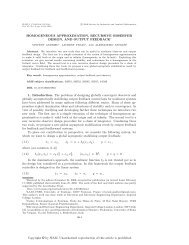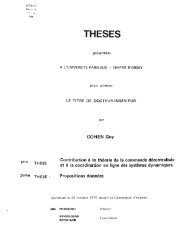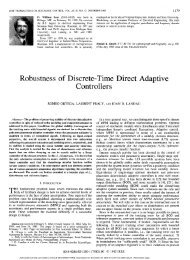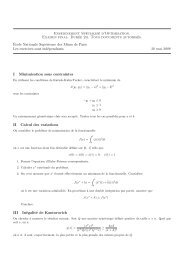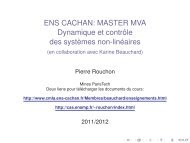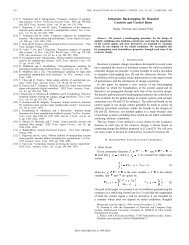Adaptive eccentricity compensation - Control Systems ... - IEEE Xplore
Adaptive eccentricity compensation - Control Systems ... - IEEE Xplore
Adaptive eccentricity compensation - Control Systems ... - IEEE Xplore
You also want an ePaper? Increase the reach of your titles
YUMPU automatically turns print PDFs into web optimized ePapers that Google loves.
<strong>IEEE</strong> TRANSACTIONS ON CONTROL SYSTEMS TECHNOLOGY, VOL. 8, NO. 5, SEPTEMBER 2000 757<strong>Adaptive</strong> Eccentricity CompensationCarlos Canudas de Wit and Laurent PralyAbstract—This paper is devoted to the problem of rejectingoscillatory position-dependent disturbances with unknown frequencyand unknown amplitude. The considered disturbancesare here assumed to be produced by <strong>eccentricity</strong> in mechanicalsystems and drives. Most of the previous works on <strong>eccentricity</strong>cancellation assume a time-depending oscillation, we insteadassume that the oscillatory disturbance is position-dependent.This leads us to formulate and to globally solve the adaptivecancellation problem using a velocity-dependent internal modelof the <strong>eccentricity</strong>. The proposed control design results in anasymptotically globally stable adaptive <strong>eccentricity</strong> compensator(AEC). An apparatus with rolling <strong>eccentricity</strong> has been build totest the controller. The paper presents a serial of experimentalresults showing the improvements of this controller. Also a comparativestudy with a simple porortional integral (PI) regulatoris presented.Index Terms—<strong>Adaptive</strong> <strong>compensation</strong>, <strong>eccentricity</strong> sinusoidaldisturbance rejection.I. INTRODUCTIONWE consider systems of the form(1)where is the system angular position, is the inertia, isthe control input and is the position-dependent oscillatorydisturbance defined asIt is assumed that the amplitude , the dimensionless frequency, and the phase of the disturbance are unknown. Theproblem considered here is thus to cancel the effect of the disturbancein the system (1).This type of problem arises as a consequence of <strong>eccentricity</strong>in many mechanical systems where the center of rotation doesnot corresponds with its geometric center. This is typically thecase on drives with magnetic bearings. It also arises in systemswith friction where the contact forces change as a function ofthe position .The dependency on position of can be visualized inthe following scenarios. It is known that the friction forces dependson the normal force acting between two surfaces. In-Manuscript received October 28, 1998; revised May 2, 1999. Recommendedby Associate Editor, M. Bodson.C. Canudas de Wit is with the Laboratoire d’Automatique de Grenoble,ENSIEG-INPG, 38402 St. Martin d’Hères, France (e-mail: canudas@lag.ensieg.inpg.fr).L. Praly is with Ecole des mines de Paris, Centre Automatique, 77305Fontainebleau, France (e-mail: praly@cas.ensmp.fr).Publisher Item Identifier S 1063-6536(00)05747-X.(2)accuracies in the geometric position of the rotating axis of arolling mill (<strong>eccentricity</strong>), will produce position dependent disturbances.In gear boxes, friction will vary as a function of theeffective surface in contact with the gear’s teeth. The two-dimensionalrolling and spinning friction causes in ball bearingsthe frictional torque to be dependent on both position and velocity.Fig. 1 shows some of these examples.Many of the existing works consider not as a position function,but as a time-dependent exogenous signal, of the formIn the previous mentioned system this hypothesis is only validif we assume that the system is operating and regulated, at constantvelocity so that becomes proportional . Disturbancesof the form (3) have been considered in problems suchas active noise and vibration control. The noise is thusassumed to be generated by the rotating machinery and transmittedthrough the sensor path. Examples rate from engine noisein turboprop aircraft [5] to ventilation noise in HVAC system[6], passing through engine noise in automobiles [10].The proposed solutions resort to “standard” adaptive algorithmsif the frequency is assumed to be known [2]. Repetitivecontrol has also been used to compensate <strong>eccentricity</strong> in rolling[7]. For the general case where both amplitude and frequencyare unknown, some approaches based on the phase-lock loopprinciple has been proposed [1], but without proof of stability.When formulating this problem in the time-domain, the maindifficulty to show global stability properties of the adaptive algorithmscomes from the fact that the unknown parameters appearnonlinearly in the (3).When the system operates under time-varying velocity profiles,in (3) becomes time-dependent generating a signalwith a large frequency contain. The position dependent disturbancemodel (2) is thus better adapted for those cases.In this paper, we present a globally stable adaptive algorithmthat solves the above mentioned problem. For this, we use a velocity-dependentstate-space representation for . An adaptiveobserver is thus designed ensuring global asymptotic stability.The observer is constructed such that can be used in openloop (for predicting oscillatory disturbances in view of diagnosticapplications), or in closed loop (to compensate for the<strong>eccentricity</strong> effect). The properties of the algorithm are invariantwith respect to the operating velocity .The second part of the paper describes the experimental evaluationof AEC-controller tested on a special purpose apparatusthat exhibits rolling <strong>eccentricity</strong>. The performance of the proposedcontroller is evaluated with several velocity signal profiles(i.e., constant, time-varying), and finally we present a comparisonwith the standard proportional integral (PI) controller.(3)1063–6536/00$10.00 © 2000 <strong>IEEE</strong>
758 <strong>IEEE</strong> TRANSACTIONS ON CONTROL SYSTEMS TECHNOLOGY, VOL. 8, NO. 5, SEPTEMBER 2000Fig. 1. Examples of systems where disturbances d(x) are positions-dependent and may produce <strong>eccentricity</strong>: the upper left figure shows an example of a systemswhere the shear force acting on the surface of contact may vary as a function of the joint angle positions, due to <strong>eccentricity</strong> on the axis of rotation if r 6= r .Inthe system with magnetic bearing (upper right), the geometric axis of the cylinder does not coincide with the axis of rotation due to unbalanced masses distribution.The left lower figure shows the spinning and rolling resistances induce a variation on the effective area of contact as a function of the inner race position and in theright lower figure this variation is due to the relative position of the gears teeth.II. CONTROL DESIGNIn this section we formulate the internal model for the disturbance, and then we present the control design that includesthe adaptive observer. We also present the stability properties ofsuch a design.Internal model for : Let , be defined asthis gives the following state-space representation for(4)(5)(6)(7)(8)The above set of equation describes the velocity-dependentstate-space (internal) model for the <strong>eccentricity</strong>.Observer structure: These equations together with systemequation (1) suggest the following observer structure:(9)(10)(11)where is an estimate for (the adaptation law for willbe designed latter). is an estimated for needed to design ourfull-order observer 1 . , and are positive constants. The vari-1 It is also possible to design a reduced-order observer, but this results in anobserver that is highly noise sensitive. Instead, we have introduced in this paperthe full-order observer that has better noise rejection characteristics.able is used to select between two possible operation modes:an <strong>eccentricity</strong> predictor if ,or if the observer isto be used in closed loop as a <strong>eccentricity</strong> compensator. isthe velocity time-profile to be followed.Error equations: We consider the problem of tracking thedesired velocity supposed to be bounded and continuousas well as its derivative. To this aim we define the adaptive <strong>eccentricity</strong>control (AEC) control as(12)with . is given by the observer above, and the adaptivelaw to be derived.Introducing the following error definitions, we have thatthe closed-loop error equations are(13)(14)(15)(16)Adaptation law: The adaptation law is derived from the followinganalysis. Introduce asand this gives(17)(18)
CANUDAS DE WIT AND PRALY: ADAPTIVE ECCENTRICITY COMPENSATION 759Fig. 2. Simulation results with v = 20cos(=2)t. Upper left: desired (v ) and closed-loop system (v) velocity. Upper right: Velocity tracking error timeprofile. Lower left: Actual (z ) and predicted (^z ) disturbance. Lower right: Time-evolution of ^(t).which suggests to defineas(21)(19)which cancels the term between the square brackets, resultingin in a seminegative function , i.e.,(22)(23)(24)Standard arguments along the Barlabat’s lemma can be here appliedto conclude that , and tend asymptotically to zero,while all the internal signal of the system remain bounded.The representation of the adaptation law (19) is appropriatefor analysis. But it cannot be implemented directly in this wayunless the system acceleration, is assumed to be measurable(note that). Alternatively, we can introduce achange of coordinates in and then show that measurement ofis not needed.To this aim, note that can be rewritten asor equivalentDefining the new variablewe haveas(25)(20)
760 <strong>IEEE</strong> TRANSACTIONS ON CONTROL SYSTEMS TECHNOLOGY, VOL. 8, NO. 5, SEPTEMBER 2000The complete set of equations defining the AEC controller canthus be rewritten in the new set of coordinates only asa function of the velocity, i.e.,(26)(27)(28)(29)(30)The following theorem summarizes our main result.Theorem 1: Consider the system (1)–(2). Consider the dynamicfeedback defined by the equation set (26)–(30). Let thecontrol gains. Then all the internalsignal of the system are bounded and the velocity trackingerror and the <strong>eccentricity</strong> prediction error tend asymptoticallyto zero.III. SIMULATION RESULTSWe present in this section a simulated example, with thesystem (1), and the AEC controller. Values used in simulationswere as follows.• System parameters(Nm),(Rad/m), (Rad).• <strong>Control</strong>ler gain .• Observer .• Adaptation law .First simulations where performed with a oscillatory velocityprofile. The first 5 s presented in the simulationsdo not use the adaptive <strong>compensation</strong> scheme (althoughthe adaptation mechanism is active since , i.e., ). Eccentricity<strong>compensation</strong> is activated during .The upper left Fig. 2, shows the velocity desired profile, and theclosed-loop velocity. Substantial improvements can be observedwith <strong>eccentricity</strong> <strong>compensation</strong> (see tracking error in the upperright of Fig. 2).The disturbance and the estimated disturbanceare shown in the lower left of Fig. 2. A fast convergence ofthe <strong>eccentricity</strong> estimated to its true value is obtained. Finallythe lower rigtht Fig. 2 gives the time-evolution of the estimatedparameter . It can be observed thati.e., .IV. EXPERIMENTAL RESULTSconverge to its true value,This section describes the experimental evaluation of AECcontroller.We first provide a description of the apparatus usedfor the experiments, then we evaluate the AEC performancewith several velocity signal (constant, time-varying), and finallywe present a statistic comparison between the AEC and the standardPI controller. More detailed description of the real-timesystem used for these experiments, as well as additional experiments,can be found in [8].A. Description of the Experimental SetupThe schematic view of the aparatus build to study <strong>eccentricity</strong>is shown in Fig. 3. The lateral view in Fig. 3 shows, from rightto left, the motor drive [0.5 KW], the gear box (with a reductionratio of ), the load, and the wheel used to producethe <strong>eccentricity</strong> effects. The front view shows the detailsof this mechanism. The load cylinder of inertia is driven bythe motor of inertia . On the top of it, we have placed a rotatingwheel (with neglected inertia), constrained by the force. The rotation wheel’s center is set to be different from itsgeometric center. The contact pressure at the point where thewheel radius is equal to , is larger than the contact pleasure atthe point of radius , since . This produces an <strong>eccentricity</strong>effect changing the normal force acting on the wheel-to-cylindercontact surface. This variation is then transmitted to the motorshaft via the gear box. The additional normal force, at the loadside, induced by this mechanism can thus be modeled as(31)where is the load angle (Rad), which is related to the motorangle position as ( is the reduction ratio).(1/m) is a constant capturing the linear part of the rubbero-ring deformation. , is the phase shift, and describes thedimensionless <strong>eccentricity</strong> frequency. This frequency is definedas the ratio between the the cylinder’s radius, and the wheel’saverage radius, i.e.,This value, although computable here in our set up, will be assumedto be unknown as may be the case in many applicationswith complicated mechanisms. Since the inertia of the wheel ofnegligible when compared to the load cylinder, other dynamiceffects of the wheel will not be considered.The model for the motor drive under this setup is given as(32)where (Rad) is the motor angular position,(Nm/s ) is the total system inertia (motor plus load), (Nm)is the control torque input, and (Nm) is the motor frictiontorque at the ball bearings. depends, among other factors,on the normal force variations induced by the eccentric wheel,and it is modeled aswith(33)(34)where is the average normal force on the ball bearings,, is as defined in (31), the parameters are the frictionparameters associated to the LuGre friction model (see [3]).
CANUDAS DE WIT AND PRALY: ADAPTIVE ECCENTRICITY COMPENSATION 761Model (32) can be rewritten as(35)with(36)(37)(38)(39)(40)(41)Fig. 3. Schematic (top) lateral view of the experimental setup to study<strong>eccentricity</strong> (bottom) front view.Fig. 4. <strong>Control</strong> block scheme of the adaptive <strong>eccentricity</strong> compensator (AEC)with feedforward friction <strong>compensation</strong>.TABLE IMOTOR, FRICTION, AND LOADPARAMETERSis the dimensionless frequency at the motor side (note thatthe <strong>eccentricity</strong> frequency effect at the motor shaft is demultipliedby the gear ratio). Note also that model (35) differs frommodel (1) by the presence of friction, and by the dependence ofon . Hence to apply to our previous adaptive <strong>eccentricity</strong>compensator, we need to cancel the friction, and to assume that, can be approximate by its steady-state value, as shown in (41).Friction can be canceled via feedforward or feedback. The approximationon may hold for most operation conditions(except for the time periods when the velocity crosses zero)since the friction dynamics of (34), is much faster than the motorvelocity dynamic (of the order of magnitude of . Theonly conceptual problem lies thus on the velocity zero crossingsthat occurs at isolated time periods. Its effects on the closed-loopperformance will be evaluated through experiments.Resuming, we have the following.• To apply our AEC strategy, we must first compensate forthe position-independent friction .• The dependency of and on is not a problem since thedynamic of is faster than the one of , and .• The effects of sign-velocity dependency of on theclosed-loop system will not be explicitly considered, butthey will be evaluated through experiments.We are thus in position to apply our control algorithm, andfor that we will use our AEC controller, with feedforward <strong>compensation</strong>They capture the distributed friction characteristics on themotor. is the friction coefficient of this integratedmodel 2 .2 In the LuGre model is replaced with the function g(v)=F +(F 0F )e (where F is the Coulomb friction, F is the Sticktion frictionlevel, and v is the Stribeck velocity) in order to include the Stribeck effect. Forsimplicity reazons, we just use which is the Coulomb friction normalizedby the Normal force. Since our main objective here is to study the <strong>eccentricity</strong>effects, we have explicitly introduced the normal force dependency in the LuGremodel, and simplified the expression of g(v).(42)where being a linear operator (when referring to the AECcontroller we will simply refer to a proportional velocity gain,i.e., ), is given by the set of (27)–(30), and is afeedforward friction prediction obtained from(43)(44)
762 <strong>IEEE</strong> TRANSACTIONS ON CONTROL SYSTEMS TECHNOLOGY, VOL. 8, NO. 5, SEPTEMBER 2000Fig. 5. Experiments under constant velocities v =30Rad/s. Upper left: Velocity tracking error (v 0 v). Upper right: control input time profile. Lower left:predicted disturbance, ^z . Lower right: time-evolution of ^(t).Fig. 4 show the block diagram of the EAC control scheme withfeedforward friction <strong>compensation</strong>. Locally, , thus theclosed-loop equation with this additional friction <strong>compensation</strong>term is similar to the frictionless system studied in the previoussection.System parameters including friction coefficients have beenestimated using a similar procedure as described in [4]. Theyare reported in Table I.The experiments were conducted on a dSPACE real-timecomputer system based on a digital signal processor, with asampling time of 1 ms. The position is measured by means ofa high-precision optical encoder of 120 000 divisions, yieldinga resolution of 0.52 rad. The velocity is is computed byposition differentiation over a sampling period. The majorsource of noise is thus caused by the numerical errors due tothis approximation.B. Performance Evaluation under Different Tracking SignalsIn this section, we presents several experiments aiming atevaluating the AEC control behavior under different operatingconditions: constant velocities, time-varying velocities, and velocityreversals. The control parameters used for these experimentswere• <strong>Control</strong>ler gains:(theand , gains are the PI-control gains used later forcomparisons.• Observer gains: .• Adaptation gains: .1) Experiments Under Constant Velocities: The experimentsin Fig. 5, show the tracking error, the prediction ,the estimate , and the control signal. The experiments arerealized at rad/s. The <strong>eccentricity</strong> <strong>compensation</strong> isapplied at s. It can be observed that the oscillatorydisturbance affecting the tracking error is canceled whenapplying the term ,in . The remaining error, which isabout 12% of before <strong>compensation</strong>, is reduced to 1.5% withthe <strong>compensation</strong>. The time-profiles shown in all the presentedfigures have been low-pass filtered to extract noise.The time evolution of , has a shape similar to a sinusoidalwave (as it has been predicted). The imperfections may
CANUDAS DE WIT AND PRALY: ADAPTIVE ECCENTRICITY COMPENSATION 763Fig. 6. Experiments under time-varying velocities v =30+10sin(=2t). Upper left: Velocity tracking error (v 0 v). Upper right: control input time profile.Lower left: predicted disturbance, ^z . Lower right: Time-evolution of ^(t).be attributed to the nonuniform deformation of the wheel contactsurface (the wheel in contact is composed of a inner undeformablesteel wheel, covered by a rubber 5 mm o-ring). The estimatedparameter is observed to converge (in average sense)to a value close to 0.055, which according to two implies that. The theoretical value of is given by theexpression (39) as, whichseems to correspond to the experimental found value (note alsothat the period of gives for a velocity of 30 rad/s, an experimentalvalue of , for a ).2) Experiments Under Time-Varying Velocities.: The experimentsin Fig. 6, show the tracking error, the prediction ,the estimated value of , and the control signal. The experimentsare realized under a positive time-varying desired velocity profile, under the same AEC controller.Note that the predicted does not necessarily resembles toa pure sinusoidal wave. Conceptually, the magnitude of thedisturbance , may change (not much) as a function of thevelocity (see discussion at the end of Section IV-A) due to theviscous friction term ,in , but this seems to have a negligibleeffect on the closed-loop performance. The main (small)difference with respect to the previous experiment, is a slightlylarge level of noise. Nevertheless, the global system behavior ispreserved. Finally, note that the value of tends to a value similarto the one obtained for constant velocity.C. Comparison Between the AEC and the PI <strong>Control</strong>lersThe effect of the disturbance on the output , in system(1), under a linear controller , can be quantifiedby looking at the spectral distribution of sensitivity function, where(45)In this section we compare the AEC-controller ,with a simpler PI-controller, usually used toregulate velocity. For this comparison to be fair, we set the gains, and , such that the PI controller have a better rejectioncharacteristics than the P controller (linear part of the AEC), in
764 <strong>IEEE</strong> TRANSACTIONS ON CONTROL SYSTEMS TECHNOLOGY, VOL. 8, NO. 5, SEPTEMBER 2000Fig. 7. Bode plots of the sensibility functions: T (s)-AEC controller and T (s)-PI controller.Fig. 8. Comparisons between the AEC and the PI controller. Upper left: velocity tracking error (v 0 v) for the AEC-controller. Upper right: velocity trackingerror (v 0 v) for the PI-controller. Lower left: AEC-control input time profile. Lower right: PI-control input time profile.
CANUDAS DE WIT AND PRALY: ADAPTIVE ECCENTRICITY COMPENSATION 765TABLE IIPERFORMANCE QUANTIFIERS OF THE COMPARISON BETWEEN THE AEC AND THE PI CONTROLLERS UNDER DIFFERENT VELOCITY PROFILES: vv =40[rad/s], v = 20 + 10 sin(0:78t) [rad/s], AND v = 40 + 10 sin(0:78t) [rad/s]=10[rad/s],the frequency domain where the spectral support of the is expectedto lie, i.e., ,andelsewhere. Fig. 7 shown the magnitudesof , and , with the given choice ofparameters.Fig. 8 shown the tracking error and the control signal for bothcontrollers with rad/s. At this velocity,has its spectrum concentrated at 4.8 rad/s. FromFig. 7, we see that is about 8 dB smaller than the one ofthe AEC. Although, the performance of the AEC-controller improvesover the PI, it may be expected that this improvement willdiminish when operating at lower frequencies where issmall.Table II shows several quantifiers (maximum value, meanvalues, variance, etc.) of the tracking error and the controlsignal under several different operation velocity profiles;(see table description).The first two set of trials correspond to constant velocities:one with low velocity and the other with higher velocity. Forthe low velocity case , the PI sensibility functionhas a substantial low magnitude. This is the less favorable casefor the AEC-controller. Nevertheless, both controllers performanceare comparable. The explicit prediction and <strong>compensation</strong>of the disturbance replace the need for a low magnitude ofthe sensitivity function at low frequencies. For larger velocities(i.e., ), the AEC-controller overperform the PI controller.The second set of trials corresponds to time-varying velocityprofiles. In some applications it is required to operate undervelocity changes. Thus linear controllers tuned for a particularoperational velocity, may degrade its performance while confrontedto changes in . The experiment concerning the profileproduce a change of velocity between ten and 30 rad/s, whilethe profile produce a change of velocity between 30 and 50rad/s. From Table II, it can be observed that in all these trials,the AEC controller improves over the PI with equivalent controlauthority.V. CONCLUSIONWe have presented a method for compensating <strong>eccentricity</strong> inmechanical systems. As a main difference with previous works,we have formulated the disturbance as a position-dependent periodicfunction, leading to a velocity-dependent state space representation.This formulation seems to be justified in most ofthe mechanical applications where <strong>eccentricity</strong> occurs.From this formulation, we have designed an adaptive predictorwhich allows to reject the <strong>eccentricity</strong> effects studiedin this paper. The adaptive <strong>eccentricity</strong> compensator has beenshown to be asymptotically stable while ensuring internal signalboundedness.We have also presented several experiments of the AEC thatdemonstrated the improvements over simpler linear controllers(PD and PID). The experiments were conducted under differentvelocity profiles with different amplitudes. The obtained resultshave demonstrated that the AEC mechanism improves over thelinear controllers. Besides that, and in opposition to some of theexisting mechanisms, our AEC do not require any gain retuningwhen operating at different velocities.We have also observed that to the internal observer signalto behave well, it was important to compensate for the motorfriction. When this was not the case, the additional bias is inthe system due to inexact friction cancellation provokes a highoscillatorybehavior on the estimate (which can be due to oneof the well-known phenomena of drift, bursting, and parameterrecovery, see for example [9]). Although, this does not changemuch the time-profile of , this particular phenomena deservesmore attention.ACKNOWLEDGMENTThe first author would like to thanks P. Posselius and H. Olofssonfor their help in performing the experiments and the interestingdiscussions that resulted during their stay at Grenoble.REFERENCES[1] M. Bodson and S. C. Douglas, “<strong>Adaptive</strong> algorithm for the rejection ofperiodic disturbances with unknown frequency,” Automatica, vol. 33,no. 12, pp. 2213–2221, 1997.[2] M. Bodson, A. Sacks, and P. Khosla, “Harmonic generation in adaptivefeedforward cancellation schemes,” <strong>IEEE</strong> Trans. Automat. Contr., vol.39, pp. 1939–1944, 1994.[3] C. Canudas de Wit, H. Olsson, K. J. Âström, and P. Lischinsky, “Anew model for control of systems with friction,” <strong>IEEE</strong> Trans. Automat.Contr., vol. 40, pp. 419–425, Mar. 1995.[4] C. Canudas de Wit and P. Lischinsky, “<strong>Adaptive</strong> friction <strong>compensation</strong>with partially known dynamic friction model,” Int. J. Adapt. Contr.Signal Process., vol. 11, pp. 65–85, 1997.
766 <strong>IEEE</strong> TRANSACTIONS ON CONTROL SYSTEMS TECHNOLOGY, VOL. 8, NO. 5, SEPTEMBER 2000[5] U. Emborg and C. F. Ross, “Active control in the Saab,” in 340 Proc.2nd Conf. Recent Adv. Active Contr. Sound Vibrations, Blacksburg, VA,1993, pp. S67–S73.[6] L. J. Eriksson, “A practical system for active attenuation in ducts,”Sound Vibr., vol. 22, no. 2, pp. 30–40, 1988.[7] S. S. Garimella and K. Srinivasan, “Application of repetitive control to<strong>eccentricity</strong> <strong>compensation</strong> in rolling,” J Dyn. Syst., Meas., Contr., vol.118, pp. 657–664, Dec. 1996.[8] H. Olofsson and P. Posselius, “Experimental Study of <strong>Adaptive</strong>Eccentricity Compensation,” Lab. Automat. Contr., Grenoble, France,Int. Rep., 1998.[9] M. España and L. Praly, “On the global dynamics of adaptive systems:A study of an elementary example,” SIAM J. Contr. Optimi., vol. 31, no.5, pp. 1143–1166, Sept. 1993.[10] R. Shoureshi and P. Knurek, “Automotive application of a hybrid activenoise and vibration control,” <strong>IEEE</strong> Contr. Syst. Mag., vol. 16, no. 6, pp.72–78, 1996.Laurent Praly received the engineering degreefrom École Nationale Supérieure des Mines de Paris,France, in 1976.After working in industry for three years, in1980 he joined the Centre Automatique et Systèmesat École des Mines de Paris. From July 1984 toJune 1985, he spent a sabbatical year as a VisitingAssistant Professor in the Department of Electricaland Computer Engineering, University of Illinois,Urbana-Champaign. Since 1985, he has continuedat the Centre Automatique et Systèmes, where heserved as Director for two years. In 1993, he spent a quarter at the Institute forMathematics and its Applications at the University of Minnesota, Minneapolis,where he was an Invited Researcher. His main interest is in feedback stabilizationof controlled dynamical systems under various aspects—linear andnonlinear dynamic output, with parametric or dynamic uncertainty. On thistopic, he is contributing both on the theoretical aspect with many academicpublications and the practical aspect with several industrial applications.Carlos Canudas de Wit was born in Villahermosa,Tabasco, Mexico, in 1958. He received the B.Sc.degree in electronics and communications from theTechnological Institute of Monterrey, Mexico, in1980. He received the M.Sc. and Ph.D. degrees inautomatic control from the Polytechnic of Grenoble,France, in 1984 and 1987, respectively.Since 1987, he has been working at the same departmentas “Directeur de recherche” at the CNRS,where he teaches and conducts research in the area ofadaptive and robot control. He is also responsible fora team on control of electromechanical systems and robotics. He teaches undergraduateand graduated courses in robot control and stability of nonlinear systems.He was a Visiting Researcher in 1985 at the Lund Institute of Technology,Sweden. His research topics include adaptive control, identification, robot control,nonlinear observers, control of systems with friction, ac and CD drives,automotive control, and nonholonomic systems. He has written the book <strong>Adaptive</strong><strong>Control</strong> of Partially Known <strong>Systems</strong>: Theory and Applications (Amsterdam,The Netherlands: Elsevier, 1988). He also edited two books, Advanced Robot<strong>Control</strong> (New York: Springer-Verlag, 1991) and Theory of Robot <strong>Control</strong>, in theSpringer <strong>Control</strong> and Communication Series.Dr. de Wit was Associate Editor of the <strong>IEEE</strong> TRANSACTIONS ON AUTOMATICCONTROL from January 1992 to December 1997 and has been Associate Editorof Automatica since March 1999.



